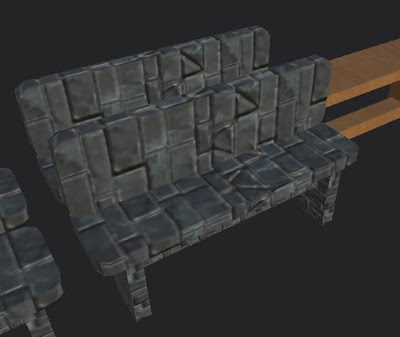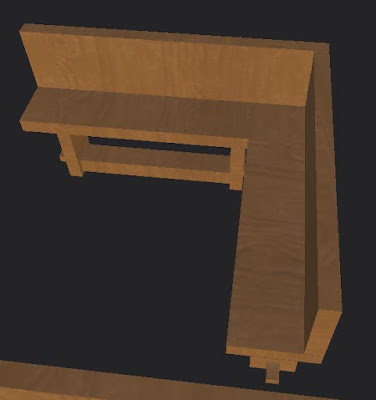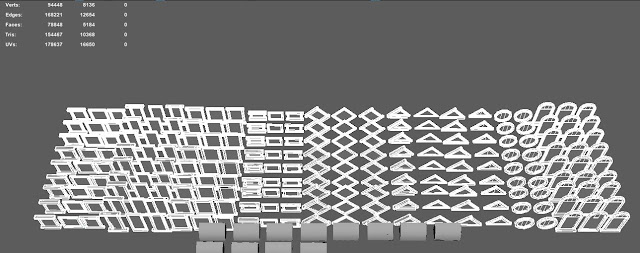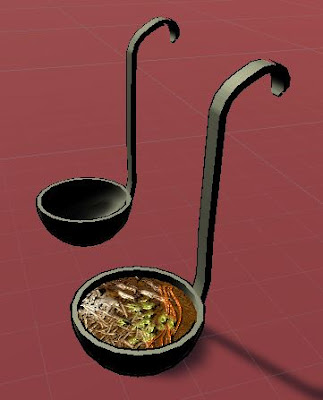Blog Post 4:
Tasks:
- Johnathan Willis, the game project lead, assigned me to create the Grocery Shop and 3D decoration models and small assets.
Completed Tasks:
- The first task I completed in Sprint 5 was finishing the task of reducing the size of the texture maps in the game from Sprint 4.
- I have finished exporting the texture maps from Substance Painter as JPEG files and uploading it into Unity.
- I have managed to reduce the amount of my texture maps to five for all of the assets I have modeled and textured.
- The second task I completed in Sprint 5 was the incomplete task in Sprint 4 modeling and texturing of the small assets: lamp post.
- For the lamp post I made four different lamp posts. A regular lamp post and I modeled three fantasy lamp posts.
- While the base of the lamp posts are structurally the same and use the same steel metal texture, the light source of the lamp post are different for each lamp post.
- The lamp post on the top left has a candle inside the glass as the light source.
- The lamp post on the top right has a hanging lantern as the light source.
- The lamp post on the bottom left has a rounded sphere as the light source.
- The lamp post on the bottom right has a scaled sphere as a light source.
- The first task I completed in Sprint 6 was the model and textured: Grocer Shop.
- I modeled the frame of the Grocery Shop and the assets outside and inside of the Grocery Shop.
- I separated the exterior and interior door of the Grocery Shop from the frame so that the programmers could add codes onto the doors for the player and the npc models could enter and exit and not apply the codes to the whole Grocery Shop..
- The assets inside and outside that I modeled were:
- The burlap bags have a burlap texture applied and are used as decorative pieces inside and outside the Grocery Shop
- I modeled a carved sign on the front of the Grocery Shop that hangs down by the front door.
- I also modeled tables with a wooden texture applied to them. The tables hold the wooden crates with a mahogany wooden texture and the bowls with a clay texture and dry food ingredient textures applied to the inner face of the bowls.
- I modeled a food scale as a prop that has a metal texture applied to it.
- I also modeled a wooden wall stand that has the mahogany wooden texture applied to it and is located behind the counter table that will hold the glass bottles Matthew made.
- As prop pieces I also modeled two types of carrots and a egg that will be used in the Grocery Shop, but can be used in the Merchant square in the town.
- The second task I completed in Sprint 6 was the modeling and texturing of the Rug.
- I modeled and textured three different size and shaped rugs to add variety.
- The first rug is a rectangle with a white fur texture applied.
- The second rug is a square with a blue wool texture applied.
- The third rug is a circle with a embroidered cloth texture applied to it.
- The third task I completed in Sprint 6 was the modeling and texturing of the upgraded Chandelier
- As I already modeled the chandelier and I am only changing the texture of the chandelier I duplicated the Chandelier mesh in Maya.
- To upgrade the look of the Chandelier I used a copper texture for the trim of the Chandelier and for the base I used a green jade texture.
- The fourth task I completed in Sprint 6 was the modeling and texturing of the task of fitting the awning I modeled and textured to fit the table that Matthew made.
- As I already modeled the awning I only need to adjust the size of the awning's trim and the length of it to fit Matthew's table.
- The table with the awning will be placed in the Merchant square in the town.
- Matthew had his own texture applied to the table but I changed the texture to the wooden texture I used on the awning so that the table would match seamlessly with the awning.
Tasks in Progress:
- I have just finished fitting the awning to the table, but there is currently no task in the 3D Backlog on Trello for me to work on as I am waiting for Thursday to discuss with Jonathan about future tasks to do.
- In the meantime I am organizing the Unity scene and the prefabs of the assets I have modeled and textured thus far.
Incomplete Tasks:
- There are no incomplete tasks and I have finished all of the tasks I have been assigned for Sprint 5 and Sprint 6.
Issues/Problems/Solutions:
- An issue I encountered in Unity was when I went to the small lab to work on the Grocery Shop when I signed into Unity and tried to open the Modeling Team's shared file in the Cloud the project was missing from the projects in the Cloud. However, when I went into the classroom's lab, a different lab from the small lab, where after signing into Unity the project was listed under the projects in the Cloud.
- The solution to the issue was that the Unity 2018.3.1 version in the small lab does not have the same version as the classroom's lab as this version is listed as Unity 2018.3.1f1 and so as there versions are not the same the project is unavailable in the small lab. So for the future I will only be able to open the project in the classrooms lab where the correct version is available.
- Another issue I encountered in Substance Painter was with the round rug. When I applied the embroidered cloth texture to the round rug there were these black spots that appeared around the rim of the rug. The black spots did not appear in Maya or in Unity and were only seen in Substance Painter and in Unity after I applied the textures to the mesh.
- The solution to this problem was to add an edge loop to the round rug model in Maya and to then re-export out the rug's mesh. After that put the new mesh into Substance Painter and apply the same texture the black spots were no longer there.
Blog Post 3:
Tasks:
- Johnathan Willis, the game project lead, assigned me to create 3D decoration models and small assets.
- The modeling team was also assigned to reduce the amount and size of all their texture maps by moving the UVs of assets onto the same UV space in Maya and to convert them from png to jpeg in Substance Painter.
Completed Tasks:
- The first task I completed in Sprint 4 was the modeling and texturing of the small asset: outdoor bench.
- For the outdoor bench I modeled modular bottom and top pieces of the bench so that the level designers can mix and match parts of the benches to create a variety to the assets in the level.
- I also made some flat top part of the benches and I made some top part of the benches that has a back piece so that the looks of the benches will vary.
- I used a wooden and stone texture for the top and bottom part of the benches so that the benches could have different looks depending on where the level designers place the benches on the level.

- The second task I completed in Sprint 4 was the modeling and texturing of the small assets: modular window pieces.
- I modeled twenty-four different types of window frames with a variance in size, shape, and thickness of the window pieces.
- I modeled the windows so that they are one-sided with no back so that the level designers can place the windows in front of any wall in the game.
- The windows have a wooden texture applied to the window frames and a basic glass texture for the window panes as
- I am applying different textures to the window panes and then getting feedback form Jonathan on which textures to apply to the window panes.
- The third task I completed in Sprint 4 was to add multiple texture sets for the window frames.
- After getting feedback from Jonathan I applied three different textures to the window panes: medieval glass, frosted glass, and stained glass.
- I applied a wooden, stone, and metal textures to the window frames to make the windows look differently from each other and to add variety.
- After duplicating the twenty-four modeled window frames there are two-hundred and nineteen different types of windows that level designers can chose from.
- The fourth task I completed in Sprint 4 was the modeling and texturing of the modular misc pieces: Fence.
- I modeled a modular fence with a front straight piece, a corner piece, and a side piece.
- The fence design is a rustic woven fence with wooden log and stick pieces of different height and thickness making up the fence.
- The textures I used for the fence was a wooden material.
- The fifth task I completed in Sprint 4 was the modeling and texturing of the modular misc pieces: Stairs and Patio.
- I made modular stair and patio pieces that the level designers can move and rotate to make different shapes and sizes of staircases and patios in the game.
- The textures I used were a wooden, metal, and stone textures to make three different sets of stair and patio pieces.
- I put together the stair pieces to make some staircases as examples of different kinds of staircases they can make with the modular pieces.
Tasks in Progress:
- I am currently working on the sixth task in Sprint 5 of reducing the size of the texture maps in the game.
- I have finished texturing the assets and I am in the process of exporting the texture maps from Substance Painter as JPEG files and uploading it into Unity.
Incomplete Tasks:
- I have not yet completed the task of modeling and texturing the lamp post asset, as this task was put on hold so that I could work on and complete the reducing of my texture map size task that I am currently working on.
Issues/Problems/Solutions:
- An issue I encountered in Maya was with the Window assets as there were mulptiple duplicated faces of the Window Frames and Window Panes.
- The solution to this problem was to un-stack the UVs and to select the extra duplicated faces and delete these faces.
- This also cut down the poly count of the 219 windows from 5,184 polys to 5,121 polys.
Blog Post 2:
Tasks:
- Johnathan Willis, the game project lead, assigned me to create 3D decoration models and small assets.
- The modeling team was also assigned to texture all completed assets with the UnityChanToonShader.
Completed Tasks:
- The first task I completed in Sprint 3 was the modeling and texturing of the small asset: cabbage
- For the cabbage I modeled a whole cabbage, a cabbage cut in half, a cabbage sliced into pieces to add variety to the assets in the level.
- Level designers can choose which stage of used cabbage they want in different parts of the tavern and at the grocery shop in the market.
- The second task I completed in Sprint 3 was the modeling and texturing of the small asset: apple.
- I modeled a whole apple with a stem coming out of the apple as well as a apple cut in half with apple seeds, and the apple cut up in slices.
- Jonathan currently wants only the apple whole model in the game and in future iterations of the game the apple half and slices may be used.
- The third task I completed in Sprint 3 was the modeling of the small asset: ladel and filled ladel.
- The ladel model is broken up into two versions: the ladel that is empty and a ladel that is filled with the soup
- In the game the empty ladel will be used first and when the ladel goes into the cauldron with soup in it the ladel will become the ladel filled with soup.
- The fourth task I completed in Sprint 3 was the modeling and texturing of the small asset: cauldron and cauldron filled.
- The cauldron model is broken up into two versions: the cauldron that is empty and a cauldron that is filled with the soup
- In the game the empty cauldron will be used first and when the player empties the food assets into the cauldron it becomes the cauldron filled with soup.
- The fifth task I completed in Sprint 3 was the modeling and texturing of the small asset: stove.
- I made two different stoves: one stove is open and the second stove is closed.
- The open stove is currently not being used in the game but may later be implemented in future game iterations.
- The closed stove has a wooden door that is latched closed.
- The sixth task I completed in Sprint 3 was the modeling and texturing of the small asset: bed.
- I split the mesh of the bed into three parts: the pillow, blanket, and the bed frame with bed mattress.
- I made each part of the bed into their own prefabs so the level designers can move or change the parts of the bed to however they want in the game.
- The seventh task I completed in Sprint 3 was the texturing of the completed decoration models and small assets completed in Sprint 1 and Sprint 2 with UnityChan Toon Shader.
- candles and candle holders
- cups, goblets, and mugs
- plates and bowls
- chandler
- lantern
Tasks in Progress:
- I am currently working on the eight task in Sprint 3 of modeling modular window pieces for the exterior of the buildings around the town in the game.
Incomplete Tasks:
- I have not yet completed the task of modeling the modular building windows, as this task is still in progress.
Issues/Problems/Solutions:
- An issue I encountered with the UnityChan Toon Shader was that the custom material made by Gavin did not work properly with the alpha map of the chains of the chandlier and lantern. The UnityChan Toon Shader material preset was texturing the rectangular polys the alpha chains were stamped on instead of just the chain alphas mask.
- Gavin, another modeler in the My Little Tavern game project, came up with a solution to this problem by suggesting that I use the UnityChan Toon Shader Clipping_or_TransClipping setting. This setting in UnityChan Toon Shader worked with alpha chains by only texturing the alpha mask and not the invisible rectangular polys.
Blog Post 1:
Tasks:
Johnathan Willis, the game project lead, assigned me to create 3D decoration models and small assets.
Completed Tasks:
- The first task I completed in Sprint 1 was the modeling of the decoration models: candles and candle holders.
- For the candle holders I modeled a tall candle holder and a short candle holder to add variety to the assets in the level.
- For the candles I modeled a tall candle, a tall deformed candle, and a small deformed candle to add variety and for the level designers to be able to group up the candles to the candle holders as in different combinations.
- The first task I completed in Sprint 2 was the modeling of the decoration models: plates and cups.
- I modeled a variety of cups, goblets, mugs, and Steiners so that there were a variety for the level designers and for the players to use in the game.
- For the plates I modeled a flat plate and a curved plate for the level designers to be able to use both to decorate the level.
- I also completed the modeling of two bowls, but I need a Trello card to submit these bowls to.
- The second task I completed in Sprint 2 was the modeling of the small asset: chandelier.
- The chandelier model is broken up into two parts: the chains and the rest of the chandelier.
- For the chandelier body I modeled a round wooden frame with metal extrusion and I re-used the candles and candle holders I previously modeled.
- I modeled a chain for the chandelier which I then used opacity and alpha blend to essentially bake it onto a rectangle shape to lower the amount of polys.
- The third task I completed in Sprint 2 was the modeling of the small asset: lantern.
- I split the mesh of the lantern into two parts: the chain and the lantern.
- I re-used the chain I modeled and baked onto the rectangle shape for the chandelier and used it for the chain of the lantern.
- I also re-used the candle that I had modeled previously.
- I modeled the lantern by making metal rings that are held together by strips of metal rectangles on the outer and inner layers of the rings.
- I am currently working on the third task in Sprint 2 of texturing all of the modeled small assets, but this Trello card is not due until February 17th.
Incomplete Tasks:
- I have not yet completed the task of texturing all of the modeled small assets, as this task is still in progress.
Issues/Problems/Solutions:
- An issue I encountered with the modeling of the chandelier small asset was that the chains increased the total number of polys to 14,000 and this exceeded the number of polys that was allowed for this asset. The design of the chandelier called for chains, but to decrease the number of polys I needed a way to have chains without all of the faces of the chains.
- Gavin, another modeler in the My Little Tavern game project, came up with a solution to this problem by suggesting that I look into alpha stamping the chains onto a rectangle shape in Maya and helped to show me how to apply this method to the chains in Maya. After applying this method the chandelier decreased to below 2,000 polys.
- Another issue I ran across for the chains in the chandelier was on how to take the rectangular mesh and to apply the chain cutout in Substance Painter and to then export this into Unity where you only see the chain and not the rectangle mesh.
- The solution I found was in various Youtube videos links below where it showed that I needed to add an opacity map and to change the channel to alpha blending in Substance Painter and from there export it out as a Unity 5 Standard Specular. In Unity you need to then change the material from opacity to cutout.
- https://www.youtube.com/watch?v=LiNIfYif9yc
- https://www.youtube.com/watch?v=pp6_SafrrbY
- https://www.youtube.com/watch?v=K2ZaDcT7uaE


































































No comments:
Post a Comment